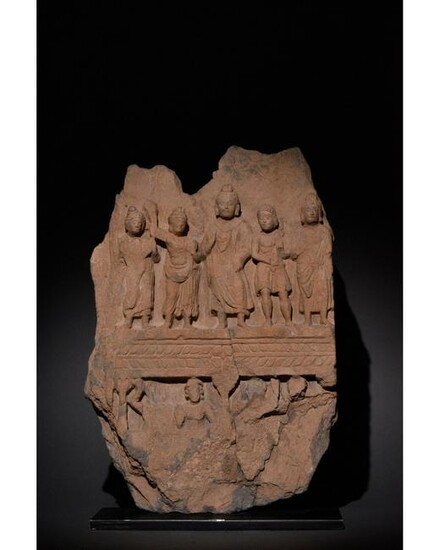GANDHARA SCHIST STONE PANEL WITH BUDDHIST SCENE
C. 100-300 AD. Gandharan. A grey-brown schist relief panel bearing Buddhist scenes arranged over two registers. Upper register: Buddha, identifiable by his characteristic topknot and large, pendulous ears, stands at the centre, wearing a flowing Kasaya (monastic robe). His hands are arranged as if for the Vitarka Mudra (the Mudra of Teaching or Discussion), a common mudra representing the discussion and transmission of Buddhist teachings. This Mudra is formed by joining the tips of the right thumb and index finger together to form a circle, keeping the other three fingers pointing straight up, and holding the hand outwards (we can infer this mudra from the arm positioning, even where hands do not survive). He is flanked by two robed attendants or worshippers on each side. These figures stand atop a rectangular plinth decorated with geometric motifs. Lower register: partially preserved and unidentifiable Buddhist scenes. Gandhara was an ancient region in the Peshawar basin in the north-west of the ancient Indian subcontinent. The Kushan period (c. 75-451 AD) of Gandharan art, to which this schist figure belongs, was the golden age of artistic production in the area. For further information on Gandharan art, see Jongeward, D. 2019, Buddhist Art Of Gandhara in the Ashmolean Museum. Oxford, Oxford University Press. Good condition. Provenance: Property of a Middlesex collector; acquired on the London art market before 2000; formerly in an old English collection since the 1970s. Size: L:With stand: 480mm / W:305mm ; 17.2kg
[ translate ]View it on
Sale price
Estimate
Time, Location
Auction House
C. 100-300 AD. Gandharan. A grey-brown schist relief panel bearing Buddhist scenes arranged over two registers. Upper register: Buddha, identifiable by his characteristic topknot and large, pendulous ears, stands at the centre, wearing a flowing Kasaya (monastic robe). His hands are arranged as if for the Vitarka Mudra (the Mudra of Teaching or Discussion), a common mudra representing the discussion and transmission of Buddhist teachings. This Mudra is formed by joining the tips of the right thumb and index finger together to form a circle, keeping the other three fingers pointing straight up, and holding the hand outwards (we can infer this mudra from the arm positioning, even where hands do not survive). He is flanked by two robed attendants or worshippers on each side. These figures stand atop a rectangular plinth decorated with geometric motifs. Lower register: partially preserved and unidentifiable Buddhist scenes. Gandhara was an ancient region in the Peshawar basin in the north-west of the ancient Indian subcontinent. The Kushan period (c. 75-451 AD) of Gandharan art, to which this schist figure belongs, was the golden age of artistic production in the area. For further information on Gandharan art, see Jongeward, D. 2019, Buddhist Art Of Gandhara in the Ashmolean Museum. Oxford, Oxford University Press. Good condition. Provenance: Property of a Middlesex collector; acquired on the London art market before 2000; formerly in an old English collection since the 1970s. Size: L:With stand: 480mm / W:305mm ; 17.2kg
[ translate ]


